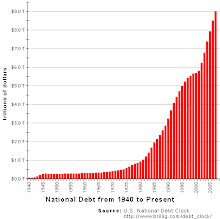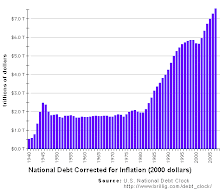Wednesday, September 10, 2008
Using Supply & Demand Analysis to Explain Unemployment
Using Supply & Demand Analysis to Explain Unemployment
In markets for labor, the price of labor is often referred to as the wage rate. Households typically supply labor to businesses. The supply of labor is upward sloping, which implies that as the wage rate increases, households are willing to supply a larger quantity of labor. Businesses typically demand labor from households. The demand for labor is downward sloping, which implies that as the wage rate increases, business demand a smaller quantity of labor. This means fewer jobs are available for workers.
The equilibrium wage rate is the price of labor at which the quantity of labor supplied equals the quantity of labor demanded. The market wage rate is the price of labor paid in a labor market. It may or may not be the same as the equilibrium wage rate. If the market wage rate is above the equilibrium wage rate, the quantity of labor supplied is larger than the quantity of labor demanded. When this occurs, there is a surplus of labor. This is also called unemployment. Thus, unemployment occurs when the market wage rate is above the equilibrium wage rate.
Market for Labor
unemployment
(excess supply
of labor)
Supply of Labor
Quantity
of Labor
Equilibrium wage
rate
Demand for Labor
Market wage rate
Price of Labor (wage rate)
O
QS
QDwhere:
QS = the quantity of labor supplied at the market wage rate
(i.e., the number of workers who want a job at the market wage rate)
QD = the quantity of labor demanded at the market wage rate
(i.e., the number of jobs offered by businesses at the market wage rate)
Explanations for the Market Wage Rate Staying
above the Equilibrium Wage Rate
Economists suggest several reasons for the market wage rate staying above the equilibrium wage rate. Consequently, it is natural and normal to always have some unemployment.
1. A minimum wage law specifies the lowest price that employers can legally pay for labor. In the absence of the law, unskilled workers would probably be paid less than the minimum wage. Thus, minimum wage laws keep the market wage rate above the equilibrium wage rate. Workers are usually paid based on their productivity. Skilled workers are generally more productive than unskilled workers and thus receive higher wages. Consequently, minimum wage laws are usually only applicable to unskilled workers. A minimum wage is an example of a price floor. A price floor is a legal minimum price at which a product can be sold. If the minimum wage is above the equilibrium wage, then the minimum wage law creates unemployment in the market for unskilled workers.
2. Labor unions are worker associations that bargain with employers over wages and working conditions. Collective bargaining is the process by which unions and business firms agree on the terms of employment. Unions frequently negotiate market wages than are above the equilibrium wages that would be paid in the absence of collective bargaining. Union contracts keep the market wage rate of union workers above the equilibrium wage rate. In some cases, unions may strike to obtain concessions from employers. A strike is the organized withdrawal of labor from a business firm by a union.
3. Efficiency wages are above-equilibrium wages paid by firms in order to increase worker productivity. Firms may find it profitable to pay high wages to improve the health of workers, to reduce worker turnover, to increase worker effort, and to attract higher quality workers. In addition to great pay, SAS, a computer software company headquartered in North Carolina, provides its workers with on-site day-care for children, medical and dental care, and recreational facilities that rival the best health clubs. It is expensive for the company to provide these added wages and benefits. Company executives argue it makes financial sense, however, because the added pay and benefits allow SAS to attract and keep the best workers in the industry. The company saves on the costs of recruiting and training personnel because workers rarely leave for other jobs. The state-of-the-art recreational facilities help keep the workers healthy. Combining this with the readily accessible doctors, dentists, and child-care allows workers to spend less time away from their jobs. Thus it makes sense for some businesses to routinely pay wages that are above the market wage for the industry.
4. There is a cultural expectation that workers receive periodic raises, but pay cuts are generally unacceptable, regardless of economic conditions. Labor markets are not like other markets. Changing the prices of other resources or products does not change the resource or product. If you change the price of a bicycle, it is still the same bicycle. If you change the price of a worker, however, the worker may change. Workers may resent the wage cut and become hurt or angry. Workers may then be less productive, whether that reaction is intentional or not. Consequently, business firms are reluctant to cut the market wage rate, even when market wages are significantly above the equilibrium wage rate in an industry.
In markets for labor, the price of labor is often referred to as the wage rate. Households typically supply labor to businesses. The supply of labor is upward sloping, which implies that as the wage rate increases, households are willing to supply a larger quantity of labor. Businesses typically demand labor from households. The demand for labor is downward sloping, which implies that as the wage rate increases, business demand a smaller quantity of labor. This means fewer jobs are available for workers.
The equilibrium wage rate is the price of labor at which the quantity of labor supplied equals the quantity of labor demanded. The market wage rate is the price of labor paid in a labor market. It may or may not be the same as the equilibrium wage rate. If the market wage rate is above the equilibrium wage rate, the quantity of labor supplied is larger than the quantity of labor demanded. When this occurs, there is a surplus of labor. This is also called unemployment. Thus, unemployment occurs when the market wage rate is above the equilibrium wage rate.
Market for Labor
unemployment
(excess supply
of labor)
Supply of Labor
Quantity
of Labor
Equilibrium wage
rate
Demand for Labor
Market wage rate
Price of Labor (wage rate)
O
QS
QDwhere:
QS = the quantity of labor supplied at the market wage rate
(i.e., the number of workers who want a job at the market wage rate)
QD = the quantity of labor demanded at the market wage rate
(i.e., the number of jobs offered by businesses at the market wage rate)
Explanations for the Market Wage Rate Staying
above the Equilibrium Wage Rate
Economists suggest several reasons for the market wage rate staying above the equilibrium wage rate. Consequently, it is natural and normal to always have some unemployment.
1. A minimum wage law specifies the lowest price that employers can legally pay for labor. In the absence of the law, unskilled workers would probably be paid less than the minimum wage. Thus, minimum wage laws keep the market wage rate above the equilibrium wage rate. Workers are usually paid based on their productivity. Skilled workers are generally more productive than unskilled workers and thus receive higher wages. Consequently, minimum wage laws are usually only applicable to unskilled workers. A minimum wage is an example of a price floor. A price floor is a legal minimum price at which a product can be sold. If the minimum wage is above the equilibrium wage, then the minimum wage law creates unemployment in the market for unskilled workers.
2. Labor unions are worker associations that bargain with employers over wages and working conditions. Collective bargaining is the process by which unions and business firms agree on the terms of employment. Unions frequently negotiate market wages than are above the equilibrium wages that would be paid in the absence of collective bargaining. Union contracts keep the market wage rate of union workers above the equilibrium wage rate. In some cases, unions may strike to obtain concessions from employers. A strike is the organized withdrawal of labor from a business firm by a union.
3. Efficiency wages are above-equilibrium wages paid by firms in order to increase worker productivity. Firms may find it profitable to pay high wages to improve the health of workers, to reduce worker turnover, to increase worker effort, and to attract higher quality workers. In addition to great pay, SAS, a computer software company headquartered in North Carolina, provides its workers with on-site day-care for children, medical and dental care, and recreational facilities that rival the best health clubs. It is expensive for the company to provide these added wages and benefits. Company executives argue it makes financial sense, however, because the added pay and benefits allow SAS to attract and keep the best workers in the industry. The company saves on the costs of recruiting and training personnel because workers rarely leave for other jobs. The state-of-the-art recreational facilities help keep the workers healthy. Combining this with the readily accessible doctors, dentists, and child-care allows workers to spend less time away from their jobs. Thus it makes sense for some businesses to routinely pay wages that are above the market wage for the industry.
4. There is a cultural expectation that workers receive periodic raises, but pay cuts are generally unacceptable, regardless of economic conditions. Labor markets are not like other markets. Changing the prices of other resources or products does not change the resource or product. If you change the price of a bicycle, it is still the same bicycle. If you change the price of a worker, however, the worker may change. Workers may resent the wage cut and become hurt or angry. Workers may then be less productive, whether that reaction is intentional or not. Consequently, business firms are reluctant to cut the market wage rate, even when market wages are significantly above the equilibrium wage rate in an industry.
Subscribe to:
Post Comments (Atom)






No comments:
Post a Comment